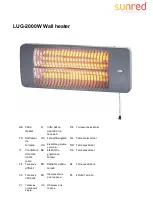
4
a
B
FIgure 7
YArwAY
TemplowHT desuperHeaTer
InstallatIon and MaIntenance InstructIons
Disassembly (see figure 10)
The TemplowHT desuperheater can
be disassembled, most easily when in
the horizontal position with the body extension
section clamped firmly in the vice.
remove nuts (16) and detach injection probe (7).
Inspect the water channels of the injection
probe by either a torch or an endoscopic
device. Check the condition of the nozzles (17).
all parts shall be free of cracks. In case of
doubt apply a dye check method for more
accurate inspection.
Check the condition of the bolts and
nuts (15, 16). Threading should show no galling
or deterioration. If they do, discard of and
replace by new parts. discard of gasket (5)
which shall be replaced by a new one.
remove the stuffing box stud, nuts (13, 14) and
gland plate (10). remove gland bushing (12).
If (12, 10) are in good condition, free of scoring
or pitting they can be re-used.
Install the upperbody (1) on a solid working
table and have an opening at the flange side
sufficiently large to allow the control cylinder
assembly (3) to be pressed out of the body (1).
There is considerable friction from the seal (4).
use a wooden bloc or other protection on
the treaded end of stem (6).
push the stem all the way down till it sits on
the bottom of cylinder (3).
use a deadweight hammer to drive the
cylinder/stem (3, 6) out of the body (1). discard
of packing (4). Make sure the index pin (8) is not
damaged at this operation.
Turn the body (1) upside down and inspect the
seat (2). seat shall be free of scratches, wire
drawing and pitting. If in good condition the
seat can remain in situ. If damaged use a pipe
wrench and unscrew the seat counterclockwise.
discard of metallic seal ring (19). This ring
cannot be re-used.
MAintenAnce
note
Maintenance of the TemplowHT desuperheater is
straight forward and does not require any special
tools or training. Care should be taken during any
maintenance operation, particularly when working
with grinders, compressed air and rotating machinery.
It is imperative that safety glasses and protective work
wear are used in accordance with standard safety
procedures. In case of doubt, consult your supervisor
or safety officer before commencing any work on
the equipment.
removal
Before removing the TemplowHT desuperheater
from the system, ensure that both the
steam -and water- pipework are pressureless
and vented. Isolate any electrical supplies
to the actuator and/or ancillaries, prior to
disconnection. Vent and remove instrument air
supply piping. loosen steam flange and water
flange bolting, but vent connections before
complete removal.
The TemplowHT desuperheater may now be
removed from the system. It is recommended
that the TemplowHT desuperheater is
transported to a convenient workshop which
has a workbench and vice. lift the unit by
means of straps around the body. do not
attempt to lift the TemplowHT desuperheater
by the yoke, actuator or any of its accessories.
depending upon the type of actuator fitted,
various stem couplings are used. Measure
accurately, and record the dimensions a and B
(see figure 7) for reassembly purposes.
also, record positions of any levers or specials
fixings, sketching if necessary, prior to removal.
If any work is required on the actuator, then please
refer to the actuator manufacturer’s manual.
remove actuator and yoke before commencing
disassembly of the TemplowHT valve.




























